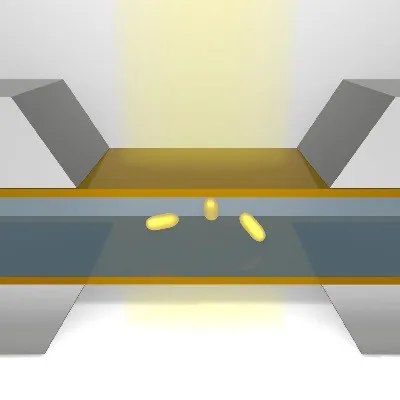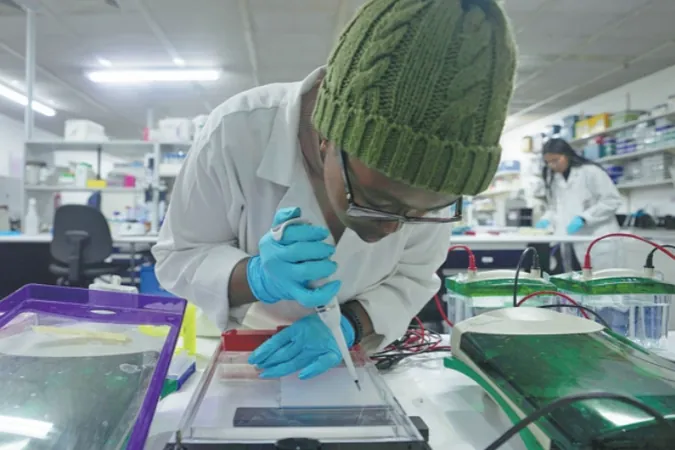
Revolutionary AI Breakthrough Unleashes Secrets of Nanoparticle Movement in Liquids!
2025-07-17
Author: Jia
Unlocking the Mysteries of the Nanoworld
Grasping the movement of nanoparticles is vital for advancing medical technologies, innovative materials, and sophisticated sensors. Yet, scientists have long faced considerable hurdles in observing and interpreting these minute motions at the atomic level.
Enter a groundbreaking AI model developed by researchers at Georgia Tech’s School of Chemical and Biomolecular Engineering (ChBE). This revolutionary tool has been designed to decode the intricate physics that dictates nanoparticle behavior.
The Power of LEONARDO
In a remarkable study published in Nature Communications, the team unveiled their AI, dubbed LEONARDO, which can analyze and even recreate motion trajectories of nanoparticles that closely mirror real-life experimental data gathered from thousands of observations.
Breaking the Barriers of Conventional Microscopy
Typical microscopes, regardless of their power, struggle to capture the dynamic motion of nanoparticles in liquefied environments. Traditional models like Brownian motion often fall short in accurately depicting the chaotic dance of these particles, which are influenced heavily by factors like fluid properties and surface interactions.
LEONARDO overcomes these challenges by employing a deep generative model capable of simulating the actions of nanoparticles observed through liquid-phase transmission electron microscopy (LPTEM). This cutting-edge method allows scientists to visualize nanoscale interactions that would otherwise elude detection.
Assistant Professor Vida Jamali, a key player in the research, emphasizes, "LEONARDO enables us to transition from mere observation to simulation, helping to generate accurate models of nanoscale motion that reflect the actual physical forces at play."
Training the AI with Gold
To fine-tune LEONARDO, researchers experimented with gold nanorods diffusing in water, collecting over 38,000 short motion trajectories under a variety of experimental conditions. This comprehensive dataset allowed the AI to generalize its predictions across diverse behaviors.
A Blend of AI and Physics
What sets LEONARDO apart is its unique ability to learn from experimental data guided by physical principles. Lead author Zain Shabeeb explains, "Many machine learning models act as black boxes, and while they provide predictions, they often lack interpretability. With LEONARDO, we’ve integrated fundamental physics into the learning process, ensuring that our model yields meaningful, interpretable results."
Utilizing a transformer-based architecture reminiscent of those behind today's advanced language models, LEONARDO deciphers the 'grammar' of nanoparticle motion, shedding light on the hidden interactions at play.
A Future Transformed by Nanoscience
The potential applications of LEONARDO are staggering. By simulating countless nanoparticle motion scenarios, this AI could revolutionize the way electron microscopes operate, possibly leading to 'smart' devices that adapt their imaging techniques in real-time.
As Jamali notes, "Understanding nanoscale motion is pivotal for various fields, including drug delivery, nanomedicine, polymer science, and quantum technologies. LEONARDO could empower scientists to design more effective materials, enhance targeted therapies, and unveil groundbreaking insights into the behavior of matter at microscopic levels."

 Brasil (PT)
Brasil (PT)
 Canada (EN)
Canada (EN)
 Chile (ES)
Chile (ES)
 Česko (CS)
Česko (CS)
 대한민국 (KO)
대한민국 (KO)
 España (ES)
España (ES)
 France (FR)
France (FR)
 Hong Kong (EN)
Hong Kong (EN)
 Italia (IT)
Italia (IT)
 日本 (JA)
日本 (JA)
 Magyarország (HU)
Magyarország (HU)
 Norge (NO)
Norge (NO)
 Polska (PL)
Polska (PL)
 Schweiz (DE)
Schweiz (DE)
 Singapore (EN)
Singapore (EN)
 Sverige (SV)
Sverige (SV)
 Suomi (FI)
Suomi (FI)
 Türkiye (TR)
Türkiye (TR)
 الإمارات العربية المتحدة (AR)
الإمارات العربية المتحدة (AR)